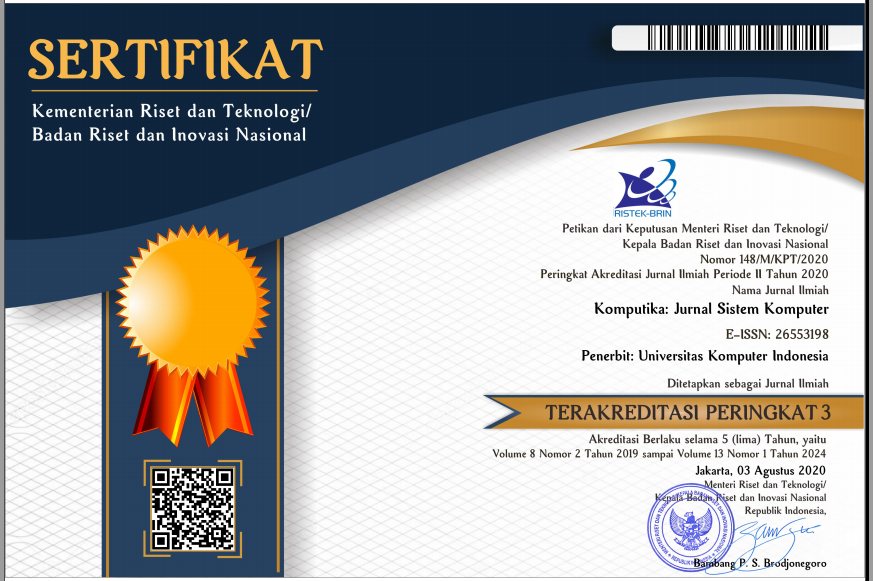Prediksi Jumlah Migrasi Penduduk dengan Menerapkan Jaringan Syaraf Menggunakan Metode Backpropagation
DOI:
https://doi.org/10.34010/0qxqxy82Abstract
Indonesia is a country that has the fourth highest population density in the world, the distribution of Indonesia's population is not evenly distributed for each region which finally the government took a policy to carry out a migration program from one region to another, thus affecting the economic development of Indonesia's population. When choosing a place to live, there are various factors that must be considered. If someone is not suitable to settle in an area or there are other driving factors, they can move or commonly known as migration. This research aims to predict the number of migrations by analyzing the results using Artificial Neural Networks with the Backpropagation Method. The Backpropagation method can be utilized by providing a relationship between population data so that it is expected in this study to achieve the right prediction. The best modeling is obtained in the 6-16-2 architecture using an input layer of 6 neurons, a hidden layer of 16 neurons and an output layer of 1 neuron. Architecture 6-16-1 produces an epoch of 8939 iterations, time 01:42, training MSE 0.00190005 and testing MSE 0.05752814 with an accuracy rate of 82%.
Keywords – Prediction; Migration; Population; Artificial Neural Network; Backpropagation Method.
References
[2] D. R. B. Bara and D. Suhendro, “Prediksi Beban Trafo pada PT PLN (Persero) UP3 Sumatera Utara Menggunakan Algoritma,” JITET (Jurnal Inform. dan Tek. Elektro Ter., vol. 12, no. 3, pp. 3647–3657, 2024.
[3] R. T. Untari and M. Devegi, “Penerapan Algoritma Backpropagation untuk Memprediksi Jumlah Permintaan Buku dan Alat Tulis,” JURTEII J. Teknol. Inf., vol. 2, no. 1, pp. 1–7, 2022.
[4] R. Ramadana and D. Suhendro, “Penerapan Metode Backpropagation dalam Peramalan Beban Trafo Daya Harian Gardu Induk pada PT PLN (Persero) UP3 Pematang Siantar,” J. intekna, vol. 23, no. 2, pp. 184–195, 2023.
[5] A. F. Pramesti and D. Suhendro, “Jaringan saraf tiruan untuk memprediksi permohonan instalasi listrik menggunakan algoritma backpropagation,” JITET (Jurnal Inform. dan Tek. Elektro Ter., vol. 12, no. 3, pp. 1548–1557, 2024.
[6] M. F. Mubarokh, M. Nasir, and D. Komalasari, “Jaringan Syaraf Tiruan untuk Memprediksi Penjualan Pakaian Menggunakan Algoritma Backpropagation,” J. Comput. Inf. Syst. Ampera, vol. 1, no. 1, pp. 29–43, 2020.
[7] R. Salis and D. Suhendro, “Prediksi Pelanggan Listrik Menurut Jenis Pelanggan pada PT PLN (Persero) UP3 Pematang Siantar Menggunakan Metode Backpropagation,” JITET (Jurnal Inform. dan Tek. Elektro Ter., vol. 12, no. 1, pp. 186–192, 2024.
[8] Y. Woli, C. D. P. B. Gabriel, and A. Adis, “Penerapan Jaringan Saraf Tiruan untuk Memprediksi Jumlah Kemiskinan di Desa Mali Iha,” J. Sains dan Sist. Teknol. Inf., vol. 5, no. 2, pp. 229–233, 2023.
[9] V. A. Lestari, A. Y. Ananta, and P. Basudewa, “Sistem Informasi Prediksi Persediaan Obat di Apotek Naylun Farma Menggunakan Holt-Winters,” J. Inform. Polinema, vol. 9, no. 2, pp. 229–236, 2023.
[10] M. Faid, F. Hasyim, and A. Khairi, “Prediksi Pemesanan Produk Untuk Membangun Permintaan Pasar Dengan Menggunakan Neuro Fuzzy,” COREAI J. Kecerdasan Buatan, Komputasi dan Teknol. Inf., vol. 3, no. 2, pp. 39–45, 2022.
[11] A. Fortillo, M. A. T. Jati, and Z. H. Nabiilah, “Pengaruh Migrasi Terhadap Kesejahteraan Masyarakat Kota,” J. Ilm. Multidisiplin Terpadu, vol. 8, no. 6, pp. 971–977, 2024.



















